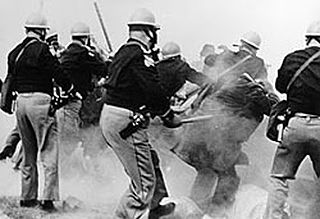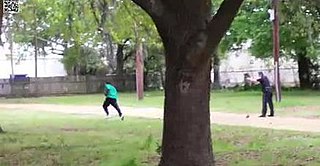
A taser is a conducted energy device (CED) primarily used to incapacitate people, allowing them to be approached and handled in an unresisting and thus safe manner. Sold by Axon, formerly TASER International, the device fires two small barbed darts intended to puncture the skin and remain attached to the target, at 55 m/s. Their range extends from 4.5 m (15 ft) for non-Law Enforcement Tasers to 10.5 m (34 ft) for Law Enforcement Tasers. The darts are connected to the main unit by thin insulated copper wire and deliver a modulated electric current designed to disrupt voluntary control of muscles, causing "neuromuscular incapacitation." The effects of a taser may only be localized pain or strong involuntary long muscle contractions, based on the mode of use and connectivity of the darts.

An electroshock weapon is an incapacitating weapon. It delivers an electric shock aimed at temporarily disrupting muscle functions and/or inflicting pain without usually causing significant injury.

The Royal Marines Police, or Royal Marines Police Troop is the Royal Marines element of the Royal Navy Police and the military police arm of the Royal Marines.

The Peel Regional Police (PRP) provides policing services for Peel Region in Ontario, Canada. It is the second largest municipal police service in Ontario after the Toronto Police Service and third largest municipal force in Canada behind those of Toronto and Montreal, with 2,200 uniformed members and close to 875 support staff.
Police misconduct is inappropriate conduct and illegal actions taken by police officers in connection with their official duties. Types of misconduct include among others: sexual offences, coerced false confession, intimidation, false arrest, false imprisonment, falsification of evidence, spoliation of evidence, police perjury, witness tampering, police brutality, police corruption, racial profiling, unwarranted surveillance, unwarranted searches, and unwarranted seizure of property.

As of 2020, more than 800,000 sworn law enforcement officers have been serving in the United States. About 137,000 of those officers work for federal law enforcement agencies.

The Anne Arundel County Police Department is the primary law enforcement agency of Anne Arundel County, Maryland, United States, serving a population of more than 564,195 per 2015 census estimates across 588 square miles (1,500 km2) of jurisdiction. The Department was created by an Act of the Maryland General Assembly in 1937, and originally consisted of a Chief of Police, three sergeants, and seventeen patrolmen.
Excited delirium (ExDS), also known as agitated delirium (AgDS) or hyperactive delirium syndrome with severe agitation, is a controversial and widely rejected diagnosis characterized as a potentially fatal state of extreme agitation and delirium. It has typically been diagnosed postmortem in young adult black males who were physically restrained by law enforcement personnel at the time of death.

The Pasadena Police Department is the police department serving Pasadena, California. The headquarters of the Pasadena Police Department is located at 207 North Garfield Avenue in Pasadena, just a block from the Pasadena City Hall and Paseo Colorado. The department employs 241 sworn officers, 13 reserve officers, and 126 civilian employees. Police chief John Perez, who spent his entire career with the department, retired and was replaced by former PPD Commander, now interim Chief Jason Clawson. The city has selected former San Gabriel, CA PD Chief Eugene Harris to take the position in January 2023.

Taser safety issues relate to the lethality of the Taser. The TASER device is a less-lethal, not non-lethal, weapon, since the possibility of serious injury or death exists whenever the weapon is deployed. It is a brand of conducted electroshock weapon sold by Axon, formerly TASER International. Axon has identified increased risk in repeated, extended, or continuous exposure to the weapon; the Police Executive Research Forum says that total exposure should not exceed 15 seconds.
Police accountability involves holding both individual police officers, as well as law enforcement agencies responsible for effectively delivering basic services of crime control and maintaining order, while treating individuals fairly and within the bounds of law. Police are expected to uphold laws, regarding due process, search and seizure, arrests, discrimination, as well as other laws relating to equal employment, sexual harassment, etc. Holding police accountable is important for maintaining the public's "faith in the system". Research has shown that the public prefers independent review of complaints against law enforcement, rather than relying on police departments to conduct internal investigations. There is a suggestion that such oversight would improve the public's view on the way in which police officers are held accountable.

On October 14, 2007, Robert Dziekański, a 40-year old Polish immigrant to Canada, was killed during an arrest at the Vancouver International Airport in Richmond, British Columbia (BC).

The Ferguson Police Department (FPD) is a law enforcement agency serving Ferguson, Missouri. Since March 14, 2023, the Current Chief of Police is Troy Doyle

Police brutality is the use of excessive or unnecessary force by personnel affiliated with law enforcement duties when dealing with suspects and civilians.
Safariland, LLC is a United States-based manufacturer of personal, and other equipment focused on the law enforcement, public safety, military, and recreational markets. It was formerly a division of the United Kingdom-based defense and aerospace company BAE Systems PLC. Safariland has said that their body armor has protected at least 2,040 police officers who were shot in the line of duty.
The Taser X2 is one of the less-lethal conducted electrical weapon (CEW) models that is used by law enforcement agencies and by civilians as a use for self-defense. It was created by TASER International, Inc. in 2011 after their popular X26 model and the similar but bulkier and heavier X3. The X2 Defender, unlike previous CEWs, can shoot two cartridges and is semi-automatic.

A body camera, bodycam, body-worn video (BWV), body-worn camera, or wearable camera is a wearable audio, video, or photographic recording system.

On April 4, 2015, Walter Scott, a 50-year-old black man, was fatally shot by Michael Slager, a local police officer in North Charleston, South Carolina, United States. Slager had stopped Scott for a non-functioning brake light. Slager was charged with murder after a video surfaced showing him shooting Scott from behind while Scott was fleeing, which contradicted Slager's report of the incident. The racial difference led many to believe that the shooting was racially motivated, generating a widespread controversy.
Edesix Ltd is a manufacturer of body worn video and digital evidence solutions based in Edinburgh, Scotland. The company designs, develops and manufacturers all its hardware and software.

In policing equipment, a police body camera or 'wearable camera', also known as body worn video (BWV), 'body-worn camera' (BWC), or body camera, is a wearable audio, video, or photographic recording system used by police to record events in which law enforcement officers are involved, from the perspective of the officer wearing it. They are typically worn on the torso of the body, pinned on the officer's uniform. Police body cameras are often similar to body cameras used by civilians, firefighters, or the military, but are designed to address specific requirements related to law enforcement. Body cameras were first worn by police in the United Kingdom in 2005, and have since been adopted by numerous police departments and forces worldwide.













